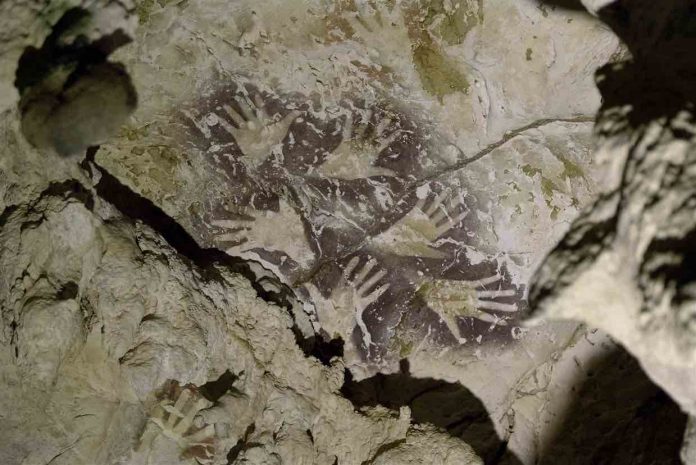The oldest figurative cave art may not belong to France or Spain, but to Borneo, researchers said Wednesday.
They found ancient hand prints, depictions of people dancing and a drawing of what appears to be a wild bovine dating back 20,000 to 50,000 years ago in a series of difficult-to-access caves on the island.
The stencils of the animals may be 40,000 or more years old, putting them in the running to be the oldest figurative artwork, the researchers reported in the journal Nature.
“The oldest cave art image we dated is a large painting of an unidentified animal, probably a species of wild cattle still found in the jungles of Borneo. This has a minimum age of around 40,000 years and is now the earliest known figurative artwork,” Maxime Aubert of Australia’s Griffith University, who led the study team, said in a statement.
Even if they are not the absolute record holders in terms of age, the images show that people across the world from one another were doing similar artwork in caves at the same time.
“It is now evident that rock art emerges in Borneo at around the same time as the earliest forms of artistic expression appear in Europe in association with the arrival of modern humans (45,000–43,000 years ago),” Aubert and colleagues wrote in their report.
The limestone caves are in a heavily forested part of Borneo’s Kalimantan province, in Indonesia. Archeologists have been exploring the difficult-to-reach caves, which had been known to be richly decorated by humans.
New dating methods show they are far older than anyone had thought they were. The team used uranium dating of the calcium carbonate deposits that built up over and around the paintings.
Some of the oldest dating involved a painting of what appears to be a type of cattle, painted in reddish-orange color.
“The image is incomplete and the animal depicted is therefore unclear, but it appears to be a large ungulate that possibly has a spear shaft protruding from its flank,” the team wrote. It may depict a banteng, a species that still exists today.
Other art dates back to around 20,000 years ago, and the findings indicate people were using the remote caves for millennia.
Much of it clearly had meaning, the researchers said.
“Many of these stencils are partly in-filled with painted lines, dashes, dots and small abstract signs that possibly represent tattoos or other marks of social identification, and in some instances hand stencils are linked together by painted mulberry lines that form intricate tree-like motifs, which perhaps symbolize kinship connections,” they wrote.
“Some figures are depicted in narrative scenes as hunting or pursuing small deer or as engaged in enigmatic social or ritual activities (for example, ‘dancing’),” they added.
Modern humans arose in Africa and spread across the world in several waves, reaching Australia across the Asia-Pacific somewhere between 50,000 and 70,000 years ago — researchers differ on this.
Modern-day Indonesia, Malaysia and Papua-New Guinea are believed to have been part of the route they took.
The same team reported in 2014 that they had discovered 40,000-year-old cave art on the Indonesian island of Sulawesi.
“Who the ice age artists of Borneo were and what happened to them is a mystery,” said team co-leader Pindi Setiawan, an archeologist at the Bandung Institute of Technology who worked on the study team.
Older hominid species also lived in the area, including the “hobbit” Homo floresiensis, whose remains date back 700,000 years.
And modern humans are not the only known cave artists. Cave art found in modern-day Spain was apparently made by Neanderthals 64,000 years ago, researchers reported earlier this year.








